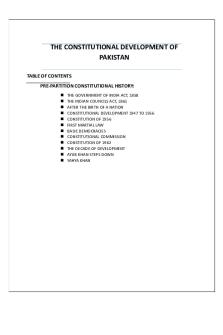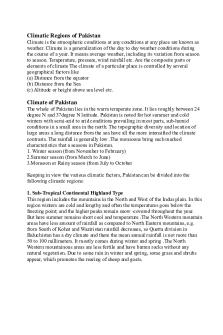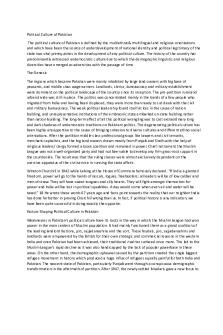Economic Consequences of Regional Disparity between East and West Pakistan PDF

| Title | Economic Consequences of Regional Disparity between East and West Pakistan |
|---|---|
| Course | pak studies |
| Institution | Bahria University |
| Pages | 10 |
| File Size | 128.7 KB |
| File Type | |
| Total Downloads | 30 |
| Total Views | 137 |
Summary
Analysis on the Economical Crisis on East and West Pakistan due to the separation of Bangladesh from Current Pakistan. This document states all difficulties and the reasons for them....
Description
Economic Consequences of Regional Disparity between East and West Pakistan
Course Pakistan History
Submitted to Miss Humera Naz
Submitted by Meerab Munawar Muhammad Abdul Rehman
Enrollment Ids 19316 19335
INTRODUCTION Pakistan achieved nationhood beneath troublesome circumstances. The partition of British India, in 1947, come about within the creation of the independent nations of India and Pakistan. Pakistan has an agrarian economy in which a small number of effective landowners with awesome possessions ruling the countryside. Pakistan had an interesting topographical include. Which comprised of two unmistakable pieces of domain. East Pakistan was not as it were separated geographically from West Pakistan by one thousand miles, but the departing land was India - an antagonistic neighbor, who from the freedom did not recognize Pakistan’s presence. At the time of parcel, they claimed about 80 per cent of the national riches of East Bengal. The larger part of urban buildings and properties, in a few cases more than 85 per cent, were claimed by the Hindus. Around 1,290 Tall schools and 47 colleges in East Bengal were secretly organized and financed by them. The Hindus comprised not more than 25 per cent of the East Bengal populace. These Hindus utilized to gain from here and sent to West Bengal and Calcutta where their relations had settled. Whereas commodities were snuck to Calcutta and anti-Pakistani writing was pouring over the border. Homogeny of individuals in numerous regards moreover contributes to the effective integration of a nation. In Joined together Pakistan, national life was diverse, other than colour and propensities. Authority of West Pakistan was based on proprietors whereas the Bengalis were driven by middle-classlawyers, teachers, and resigned authorities. Within the moment constituent get together (195658), out of 40 individuals from West Pakistan 28 were proprietors and Dukes, though East Pakistan was represented by 20 legal counselors and 9 resigned authorities. None of Bengali Part of Constituent Assembly was proprietor. The larger part of the population of West consist of small farmers who cultivate small plots for living. Less rainfall in West Pakistan forced farmers to rely on British produced irrigation system. Pakistan had nearly no industry in 1947. Beneath British run the show, the area that got to be Pakistan proliferating rural items for preparing to the region that got to be the autonomous India. Whereas the locale of East Pakistan was for the most part undeveloped. Ports, transportation and other administrations such as banking and government segment were nearly immature. So the individuals of East Pakistan needed a pioneer, who might take their errand of patriotism and defend their oppressed rights. Economically, East Pakistan was the poorest province in mechanically as well as actually it was in reverse. The economist assumed more prominent centrality within the light of its extraordinary backwardness and indigent conditions. With these dazzling contrasts and handicaps, East Pakistan required extraordinary dealing with to not as it were keep its individuals spurred and trustworthy but too keep its political and financial conditions steady.
Independence of East Pakistan Pakistan appeared on the world map as a sovereign state after the division of British India in 1947 as two wings, namely, East and West, set apart thousands miles without a common border and surrounded by Indian territory. The separation of East Pakistan didn’t engulf the country over the night but it was the accumulation of events even before the independence in ’47 coupled with separatist movement that was on the basis of Bengali nationalism claimed on ethnic and cultural grounds which led to the most tragic event in the history of the country. Many factors, like the geographical and socio-cultural difference between the two parts, the language issue, the economic disparity and exploitation of the East-Pakistan, disparity in government services and armed forces, the decline of Muslim League, rise of Bengali separatist, and the political grievances and alienation of East Pakistan, were responsible for the decay that finally resulted in the separation of East Pakistan and the dismemberment of the country. Early dissatisfaction of the East wing from economic and administrative conditions in Pakistan was highlighted almost immediately after independence. East Pakistan claims to have Dhaka being made capital instead of Karachi as the population of East was in majority, therefore on democratic principles it was only fair that the capital should have been in the East wing. The location of the Capital, it was said, created greater economic imbalance, uneven distribution of national wealth and privileges, and better jobs for the people of West Pakistan, because they were able to stir decisions in their own favor. The vast sums of foreign exchange earned through jute being spent on defense and on the cause of Kashmir was questioned as it would have proven productive to build dams and barrages for flood control, eradicate poverty and illiteracy and better food supply and shelter for the people of East Pakistan. The people of East Pakistan resented the idea of white collar jobs being awarded to West and declared it as sheer regional prejudice. The idea for two or more Muslim states in India, the demand for autonomous and sometimes separate Bengali state and the efforts for establishment of united Bengal provided an ideological base for the Separatist Movement. These elements founded an excellent and unique challenge for the founding leaders of Pakistan who wanted the unity of Muslim majority areas. The foundation of Pakistan had provided them an excellent chance to unite the Muslims of the Subcontinent in one nation state. However the seeds of separatism had taken birth even before the independence of Pakistan. The separatist elements weren’t as strong within the start as Muslims of the subcontinent had achieved a great success against their opponents in the form of Pakistan and the public was jubilant on the success. Because of this dissatisfaction and on the basis of the ideological difference of Bengali nationalist, they started to form different organizations, which in the later stages led the activities that turned into a movement for the demand of a separate Bengali state. In East Pakistan, considerable opposition had developed against the Muslim League, which had govern the province since independence. This tension was toppled in 1952 by a series of riots that rose because of Muslim League attempt to make Urdu the sole national language of
Pakistan, although Bengali-the predominant language of the eastern sector - was spoken by majority Pakistan’s population. The language riots further ignited the Bengalis, and they rallied behind their more indigenous parties to thwart what they argued was an effort by the West wing. East Pakistan opposed Urdu as the only state language on the basis that if Urdu is made the sole state language, the educated Bengalis will become illiterate and disqualified for government services. Despite the fact that Bengali was recognized as the state language along with Urdu in the Constitution of 1956, it was too late to defuse the rising opposition for separation. The poor representation of people of East Pakistan in civil services and army was one the major factors which constitute the dissatisfaction among the masses. As the East did not have adequate representation in the armed forces and the bureaucracy, they always opposed military rule and never trusted these two players in the body politic of Pakistan. The disparity in the civil services and Armed Forces was rapidly disappearing because in 1966, Ayub Khan had allocated 60% of the vacancies to East Pakistan. In 1965, the East Pakistan CSP officers constituted 34% of the total strength of the Civil Services but by 1969, their share had risen to 40.8%. Yahya Khan tried to relieve the situation by encouraging Bengalis in the top positions of the administration and as such made six Bengali CSP officers “Central Secretaries” and gave instructions to all the ministries that whenever a senior post became vacant, the Bengali candidates should be given priority ‘even if this meant disregarding of the principle of seniority’. The appointments for Bengali recruitment in the armed forces were also doubled. It was a step in the right direction but came late; it should have been taken in the early 1960s when Bengali nationalism was still in a nascent stage. After the death of popular East Pakistan leader, Hussain Shaheed Suharwardi, Mujeeb was now alone in the spotlight and able to promote his ideology. By the 1960s, the East leaders felt that they could only emancipate if the strong central government was replaced by autonomous and relatively more powerful provinces. After Mujeeb announcement of his famous Six Points on February 6, 1966, it was regarded by West Pakistan as a move for secession. What made Mujeeb prominent was the Agartala Conspiracy case in January 1968. He along with thirty-four other Bengali leaders were accused of planning the secession of East Pakistan and the establishment of an independent Bengal with the Indian assistance. When the trial took place in July 1968, it caused a bitter reaction in East Pakistan. Mujeeb came out of the trial looking like a hero after he was released from the prison under public pressure. The trial gave such popularity to Mujeeb that would, otherwise, have taken a lifetime to acquire. The rift between the central Government and the people in the Eastern Wing had become so great that what Ayub Khan regarded a treason was an act of patriotism and service to the people of East Pakistan. President Yahya Khan accepted various demand of East Pakistan leaders hoping that if the East were given their due shares in economic and political fields, the separatist tendencies in East Pakistan would be neutralized. After the restoration of political activity, Sheikh Mujeeb’s campaigned vehemently for his six point formula. During his election campaign, the providence of the Legal Framework Order of 1970, was completely distorted. In the meantime, a number of factors added to the landslide victory of Awami League. The disaster unleashed by the flood and
the cyclone in August, 1970 and incompetence of the administration to cope with the grieve situation provided enormous support to Mujeeb's allegations about the indifferent attitude of the central government towards the suffering of East Pakistan and asked the people to vote for his six point. After getting a landslide victory in the elections, Mujeeb became adamant about his six points. President General Yahya Khan and Z.A. Bhutto held talks with Mujeeb respectively on January 12 and January 27, 1971, but couldn’t reach a clear conclusion from him about the modification of his six points. President Yahya Khan on March 15 visited Dhaka to hold negotiations with Mujeeb, the situation in Bengal was worse at that time. The army action was taken on 25th and 26th of March. The main battle took place between the West Pakistan garrison, armed forces of East Pakistan regiments, the East Pakistan rifles and the border guards. Majority of the military was directed against these secessionist forces. Mujeeb was arrested that night. Law and order was restored in Dhaka soon, but the army had to face heavy resistance in other districts like Rajshahi, Chittagong and Pabna by the Mukti-Bahini forces. Near the end of April, the Pakistan army was able to regain control of the various districts and areas of East Bengal. India launched an attack against East Pakistan on November, 22 1971 and in only 25 days the larger, well equipped and well organized Indian force managed to achieve victory over the ill equipped and unorganized Pakistan armed Forces, which eventually led to surrender on December 16, 1971 and East Pakistan emerging as a free state of Bangladesh.
Analysis The separation of East Pakistan was a great event for the people of Bangladesh. To them, it looked like they had finally rid themselves of their tyrannical government and were free to rule over themselves. But to west Pakistan, this was a betrayal and a terrible loss. Since its creation, East Pakistan had been the main source of export for the country. It almost single handedly kept the entire country economically stable. Therefore when Bangladesh was created, west Pakistan lost its economic support and began to flounder. With their earnings from jute export gone, West Pakistan had to find a new way to support their economy. Now, many people in modern day Pakistan may argue that the separation was harmful and should never have happened. However if we ask the same question to a person from Bangladesh they would say that this was in fact a good thing and that they were glad it happened. Before the partition, the government mainly consisted of representatives from west Pakistan with the eastern wing not having as many representatives. This led to them being neglected and their problems were ignored with those of the people of the west taking precedence. They saw that west Pakistan was not supporting them but actually holding them back. This was made apparent during the 1971 elections in which despite the Awami League winning a majority, the government of west Pakistan treated them with disdain and refused to accept Mujeeb ur Rehman as the PM.
Economy of West Pakistan after Split On the financial front, East Pakistan slacked behind generally due to terrible planning and legacy of the past. While the economic relations were expanding between the two zones of Pakistan so was the disparity in living standards between the two wings. Whereas there was a little difference in the per capita income as west was 50% forth than east. Financial progress was supported by inheritance in west in form of developed infrastructure and entrepreneurial talent from India. Financial development in the east was backward because of overpopulation and mostly of them consist of farmers and tenants that entirely depends on the funding from West. Economic growth in east was very slow. Moreover the green revolution only occurred in West exclusively in 1960s which constituted a highly visible success in terms of economy. Contrary in 1970s the east economy experienced floods and cyclones which devastated the large area and exposed the regions vulnerability and financial helplessness. In turn, all easterners were convinced enough that east is largely exploited by the west. The element that convinced them to split up is the new trading system which would not be worse off, if not better off, after the split. But, the chances of economic growth largely depended upon the distribution of debt and foreign exchange assets among the two. The reality is that when the country split in 1971 into two nations, the economy was too broken from the middle. The resources were close to contracting by paying the obligation and other installments. This incident of 1971 moved Pakistani economy once more to zero; all accomplishments of Pakistan amid 1947-1971 went into unsuccessful Undoubtedly the burdens of our ever sick cotton material industry, which is the greatest industry of private division, was also effected in 1971 by losing its jute creating range and as well its East Pakistani market for its wrapped up products. Caught within the financial disquietude Pakistan had to devalue its cash. Separate economy lead to loss in east market and west had to look for another alternative for supply of goods that were importing from east. After the split, in 1970s, West Pakistan experienced the deficit of $352 million (exports $338 million and imports were $690 million). When west traded with East they had surplus of $78 million. West Pakistan couldn’t redirect the sales fully to other markets as the commodities they exported to East Pakistan were of low quality. Though west was successful in increasing textile exports but it constrained later due to specific quota in United States and European Union. The exports of raw cotton experienced the great fall as the domestic consumption increased. Precisely, West Pakistan in short run couldn’t recovered the loss of sales by increasing the exports. The chances of trade deficit of West were to be increased with the passage of time, unless they reduce their imports. But even if imports were to be assumed 0 West would see the trade deficit of $400 million. At that time it was established that problem would not be in finding the substitute
but the comfortable foreign exchange, if not found will affect economic development in long term.
Not only just trade deficit, independent West Pakistan was to experience a serious economic recession. Manufacturers of Cotton textile would lose two fifths of what is currently their production for domestic market and about one-fourth of their total market. The other major breaking down result of the partition of East Pakistan was that the treasury of the nation got to be quickly purge. For example, some remote news organizations has evaluated that amid the military operation of 141 1971, from begin of Walk to the conclusion of November, amid the nine months, the everyday uses was two crore. So also, the completely sixty billion rupees were evaluated within the operation fetched on the inner revolt of East Bengal. The expenditure of the 1971 war against India was isolated during November and December. Delay within the financial and efficiency framework of the nation is also a huge misfortune amid the entire year of 1971. After the war the reorganization of the military and rebuilding of the economy, the nation had to bear so many expenses also. The western Papers assessed at this decay pakistan had to bear the loss of $2, 000,000000. The economic improvement of Pakistan after 1971 includes at slightest two subjects of great significance. One is the quality and execution of the previous West Pakistan economy taking after the arrangement of Bangladesh; the other is the characteristics of its advancement arrangements and programs. In see of this, it was not conceivable to avoid the nearby advertise from foreign makers such an degree as was regular within the past. Bangladesh's separation and Bhutto government after getting to be in unused loaning for World Bank not as it were the conditions that the rupee depreciation but too Pakistan had to permitted 70, 80 per cent outside items in Pakistani markets whose entry was prohibited some time recently it. As a result of the division of Bangladesh made emergency in the advertise for mechanical items and generation. After the partition of East Pakistan key alter was vital in Pakistan's commerce. Historically, both nations were vital trade partner. On the whole, a separate West Pakistan came across several economic dislocations, an economic recessions, and deteriorating Balance of Payment situation. Devaluation of rupee was essential at that time to attract foreign exports. But enormous amount of foreign aid was necessary to grow further.
Independent East Pakistan A free East Pakistan confronted genuine adjust of installment issues but not as serious as of West Pakistan. In 1970s, they confronted approximately $ 31 million exchange shortage. In spite of the fact that the exchange with West was influenced but terms of exchange were moved forward and modern exchange designs were to be created truly quick. Not at all like West Pakistan, East Pakistan will proceed its exchange with India. East Pakistan and west Bengal shaped characteristic exchanging zone. Earlier to the union East Pakistan given Calcutta with nourishment and crude fabric for industry and in trade they got fabricated merchandise, fuel and development fabric. But after parcel the ranges ended up less subordinate on each other but the potential for exchange still existed. India provided East with cotton material and tobacco whereas paper and paper items were provided from East to India. East utilized to offer 65% of its paper generation to inter-wing exchange, which was coordinated to India and it cost a part less that inter-wing exchange since of less transportation fetched. Moreover the jute was being provided ...
Similar Free PDFs

Consequences of Instrumental
- 2 Pages

Consequences Of The Fall
- 5 Pages

Constitutional History of pakistan
- 16 Pages

25 Banks of PAKISTAN
- 25 Pages

Climatic Regions of Pakistan
- 2 Pages

Political culture of Pakistan
- 11 Pages
Popular Institutions
- Tinajero National High School - Annex
- Politeknik Caltex Riau
- Yokohama City University
- SGT University
- University of Al-Qadisiyah
- Divine Word College of Vigan
- Techniek College Rotterdam
- Universidade de Santiago
- Universiti Teknologi MARA Cawangan Johor Kampus Pasir Gudang
- Poltekkes Kemenkes Yogyakarta
- Baguio City National High School
- Colegio san marcos
- preparatoria uno
- Centro de Bachillerato Tecnológico Industrial y de Servicios No. 107
- Dalian Maritime University
- Quang Trung Secondary School
- Colegio Tecnológico en Informática
- Corporación Regional de Educación Superior
- Grupo CEDVA
- Dar Al Uloom University
- Centro de Estudios Preuniversitarios de la Universidad Nacional de Ingeniería
- 上智大学
- Aakash International School, Nuna Majara
- San Felipe Neri Catholic School
- Kang Chiao International School - New Taipei City
- Misamis Occidental National High School
- Institución Educativa Escuela Normal Juan Ladrilleros
- Kolehiyo ng Pantukan
- Batanes State College
- Instituto Continental
- Sekolah Menengah Kejuruan Kesehatan Kaltara (Tarakan)
- Colegio de La Inmaculada Concepcion - Cebu









